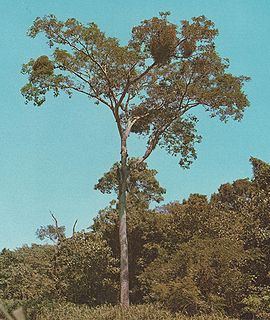
Pithecellobium dulce, commonly known as Manila tamarind, Madras thorn, or camachile, is a species of flowering plant in the pea family, Fabaceae, that is native to the Pacific Coast and adjacent highlands of Mexico, Central America, and northern South America. It is also sometimes known as monkeypod, but that name is also used for several other plants, including Samanea saman. It is an introduced species and extensively naturalized in the Caribbean and Florida, as well as the Philippines and Guam via the Manila galleons. It has also been introduced to Thailand and South Asia, It is considered an invasive species in Hawaii.

Albizia inundata is a perennial tree native to South America. Common names include maloxo, muqum, paloflojo, timbo blanco, timbo-ata, and also "canafistula" though this usually refers Cassia fistula.
Albizia berteriana, the Bertero albizia, is a species of plant in the family Fabaceae. It is found in Cuba, the Dominican Republic, Haiti, and Jamaica.
Pithecellobium decandrum is a species of flowering plant in the legume family, Fabaceae. It is endemic to Brazil, where it occurs in the forests of the Amazon River valley and along its tributaries.
Albizia pistaciifolia is a species of plant in the family Fabaceae. It is found in Colombia, Ecuador, and Venezuela.

Pithecellobium is a genus of flowering plants in the legume family, Fabaceae. The generic name is derived from the Greek words πιθηκος (pithekos), meaning "ape" or "monkey," and ελλοβιον (ellobion), meaning "earring," which refers to the coiled shape of the fruit pods. Plants of the genus are known generally as blackbeads.
Chloroleucon foliolosum is a tree species in the legume family (Fabaceae). It is found in Argentina, Brazil and Bolivia.
Pithecellobium pithecolobioides, known as Granadillo de Río, is a tree species in the legume family (Fabaceae).
Abarema glauca, the glaucous abarema, is a tree species in the legume family (Fabaceae). It is found in Cuba, Dominican Republic, and Venezuela. Common rural names are: caracolí, nijaguao, paují (Pittier), jijaguao, and merey montañero (Hoyos). Abarema glauca is found most easily on the east coast of Dominican Republic, in Uvero Alto, north of Punta Cana..
Pithecellobium seleri is a species of plant in the family Fabaceae. It is found in Guatemala and Honduras.
Zygia cognata is a tree species in the legume family (Fabaceae). It is found in Belize, Guatemala, and Honduras.

The black-bellied hummingbird is a species of hummingbird in the family Trochilidae.
Podocarpus purdieanus is a species of conifer in the family Podocarpaceae. It is endemic to Jamaica. Its common name is yacca, or St. Ann yacca.

Archidendron bigeminum is a tree species in the legume family (Fabaceae). It is found in India and Sri Lanka. It is known as "kalitiya - කලටිය" in Sinhala.
Beauprea congesta is a species of plant in the family Proteaceae. It is endemic to New Caledonia.

Helicia is a genus of 110 species of trees and shrubs, constituting part of the plant family Proteaceae. They grow naturally in rainforests throughout tropical South and Southeast Asia, including India, Sri Lanka, Indochina, Peninsular Malaysia to New Guinea and as far south as New South Wales.
Helicia retusa is a species of plant in the family Proteaceae. It is endemic to Papua New Guinea.
Roupala sphenophyllum is a species of plant in the family Proteaceae. It is endemic to Peru.
Stenocarpus dumbeensis was a species of plant in the family Proteaceae. It was endemic to New Caledonia.

Melanis pixe, the red-bordered pixie, is a species in the butterfly family Riodinidae. It was described by Jean Baptiste Boisduval in 1836.







